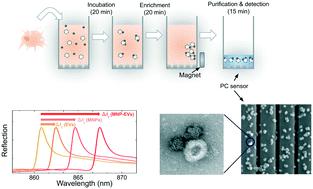Our official English website, www.x-mol.net, welcomes your
feedback! (Note: you will need to create a separate account there.)
Towards nanovesicle-based disease diagnostics: a rapid single-step exosome assay within one hour through in situ immunomagnetic extraction and nanophotonic label-free detection
Lab on a Chip ( IF 6.1 ) Pub Date : 2021-07-13 , DOI: 10.1039/d1lc00446h Qinming Zhang 1 , Hannah J Loghry 2 , Jingjing Qian 1 , Michael J Kimber 2 , Liang Dong 1, 3 , Meng Lu 1, 3, 4
Lab on a Chip ( IF 6.1 ) Pub Date : 2021-07-13 , DOI: 10.1039/d1lc00446h Qinming Zhang 1 , Hannah J Loghry 2 , Jingjing Qian 1 , Michael J Kimber 2 , Liang Dong 1, 3 , Meng Lu 1, 3, 4
Affiliation

|
Exosomes have been considered as high-quality biomarkers for disease diagnosis, as they are secreted by cells into extracellular environments as nanovesicles with rich and unique molecular information, and can be isolated and enriched from clinical samples. However, most existing exosome assays, to date, require time-consuming isolation and purification procedures; the detection specificity and sensitivity are also in need of improvement for the realization of exosome-based disease diagnostics. This paper reports a unique exosome assay technology that enables completing both magnetic nanoparticle (MNP)-based exosome extraction and high-sensitivity photonic crystal (PC)-based label-free exosome detection in a single miniature vessel within one hour, while providing an improved sensitivity and selectivity. High specificity of the assay to membrane antigens is realized by functionalizing both the MNPs and the PC with specific antibodies. A low limit of detection on the order of 107 exosome particles per milliliter (volume) is achieved because the conjugated MNP–exosome nanocomplexes offer a larger index change on the PC surface, compared to the exosomes alone without using MNPs. Briefly, the single-step exosome assay involves (i) forming specific MNP–exosome nanocomplexes to enrich exosomes from complex samples directly on the PC surface at the bottom of the vessel, with a >500 enrichment factor, and (ii) subsequently, performing in situ quantification of the nanocomplexes using the PC biosensor. The present exosome assay method is validated in analyzing multiple membrane proteins of exosomes derived from murine macrophage cells with high selectivity and sensitivity, while requiring only about one hour. This assay technology will provide great potential for exosome-based disease diagnostics.
中文翻译:

迈向基于纳米囊泡的疾病诊断:通过原位免疫磁性提取和纳米光子无标记检测在一小时内进行快速单步外泌体检测
外泌体被认为是疾病诊断的高质量生物标志物,因为它们作为纳米囊泡被细胞分泌到细胞外环境中,具有丰富而独特的分子信息,可以从临床样本中分离和富集。然而,迄今为止,大多数现有的外泌体检测都需要耗时的分离和纯化程序;检测特异性和灵敏度也需要提高,以实现基于外泌体的疾病诊断。本文报道了一种独特的外泌体检测技术,该技术能够在一小时内在单个微型容器中完成基于磁性纳米颗粒 (MNP) 的外泌体提取和基于高灵敏度光子晶体 (PC) 的无标记外泌体检测,同时提供改进的灵敏度和选择性。通过使用特异性抗体对 MNP 和 PC 进行功能化,可以实现对膜抗原的检测的高度特异性。检测下限约为 10与不使用 MNP 的单独外泌体相比,共轭的 MNP-外泌体纳米复合物在 PC 表面提供了更大的指数变化,因此实现了每毫升(体积) 7 个外泌体颗粒。简而言之,单步外泌体检测包括 (i) 形成特定的 MNP-外泌体纳米复合物,以直接在容器底部的 PC 表面上从复杂样品中富集外泌体,富集因子 >500,以及 (ii) 随后,执行就地使用 PC 生物传感器对纳米复合物进行定量。本外泌体测定方法在分析源自鼠巨噬细胞的外泌体的多种膜蛋白方面得到验证,具有高选择性和灵敏度,同时仅需约一小时。这种检测技术将为基于外泌体的疾病诊断提供巨大的潜力。
更新日期:2021-07-21
中文翻译:

迈向基于纳米囊泡的疾病诊断:通过原位免疫磁性提取和纳米光子无标记检测在一小时内进行快速单步外泌体检测
外泌体被认为是疾病诊断的高质量生物标志物,因为它们作为纳米囊泡被细胞分泌到细胞外环境中,具有丰富而独特的分子信息,可以从临床样本中分离和富集。然而,迄今为止,大多数现有的外泌体检测都需要耗时的分离和纯化程序;检测特异性和灵敏度也需要提高,以实现基于外泌体的疾病诊断。本文报道了一种独特的外泌体检测技术,该技术能够在一小时内在单个微型容器中完成基于磁性纳米颗粒 (MNP) 的外泌体提取和基于高灵敏度光子晶体 (PC) 的无标记外泌体检测,同时提供改进的灵敏度和选择性。通过使用特异性抗体对 MNP 和 PC 进行功能化,可以实现对膜抗原的检测的高度特异性。检测下限约为 10与不使用 MNP 的单独外泌体相比,共轭的 MNP-外泌体纳米复合物在 PC 表面提供了更大的指数变化,因此实现了每毫升(体积) 7 个外泌体颗粒。简而言之,单步外泌体检测包括 (i) 形成特定的 MNP-外泌体纳米复合物,以直接在容器底部的 PC 表面上从复杂样品中富集外泌体,富集因子 >500,以及 (ii) 随后,执行就地使用 PC 生物传感器对纳米复合物进行定量。本外泌体测定方法在分析源自鼠巨噬细胞的外泌体的多种膜蛋白方面得到验证,具有高选择性和灵敏度,同时仅需约一小时。这种检测技术将为基于外泌体的疾病诊断提供巨大的潜力。











































 京公网安备 11010802027423号
京公网安备 11010802027423号